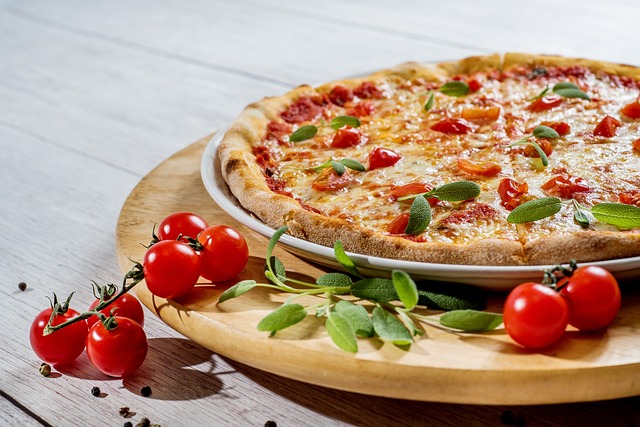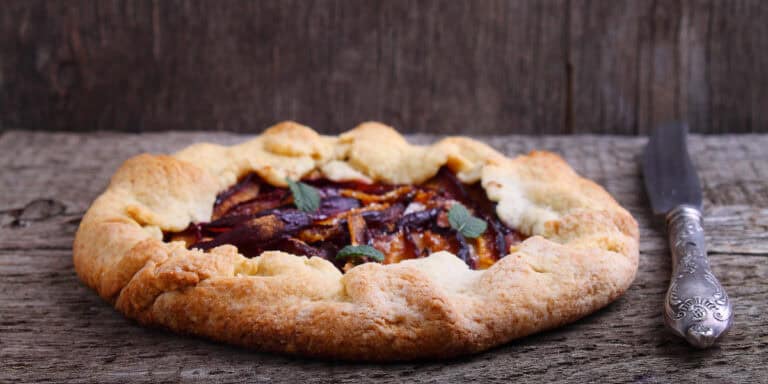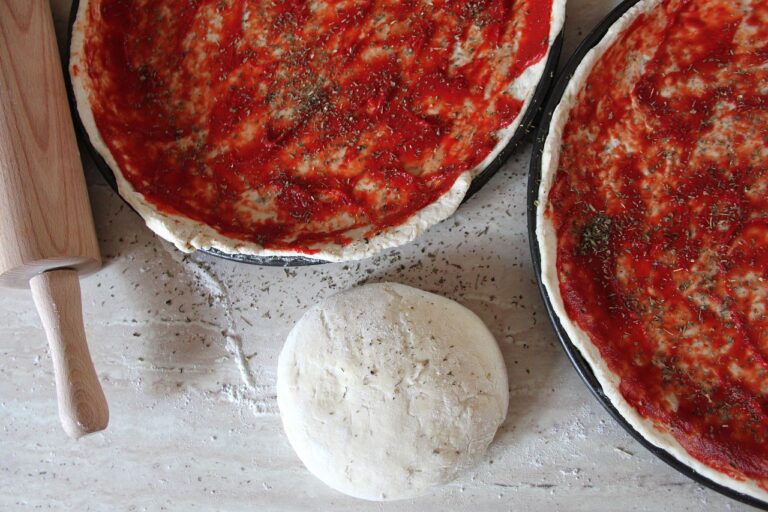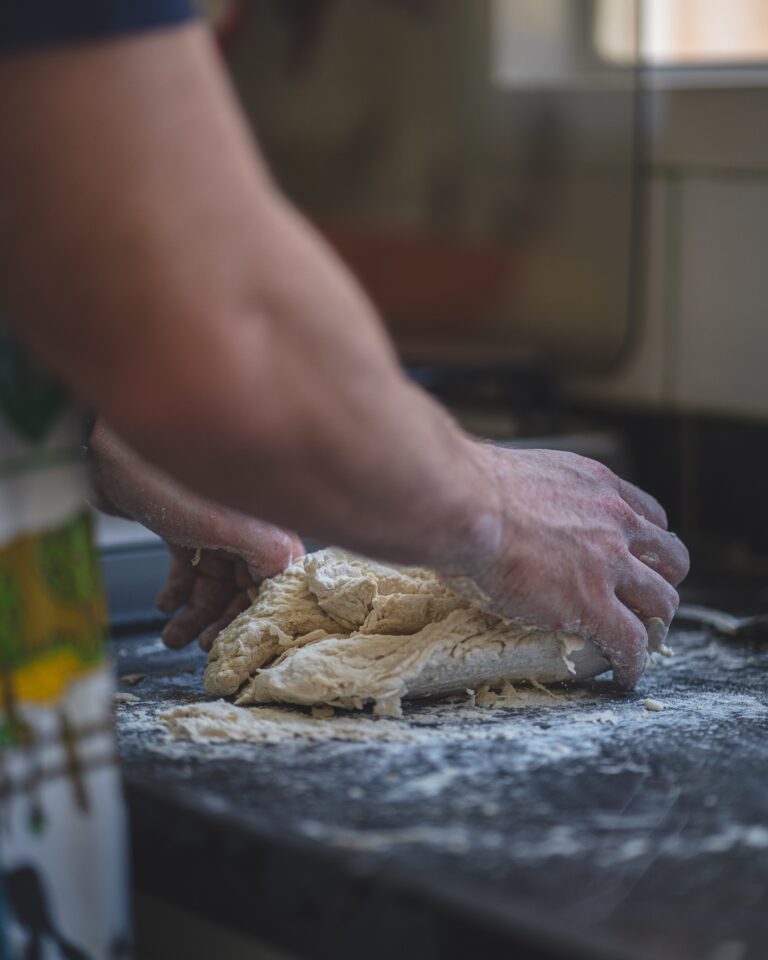Homemade Pizza Crust Recipe
Are you tired of ordering pizza that just doesn’t hit the mark? Look no further – we’ve got the ultimate homemade pizza crust recipe for you. With just a few simple ingredients and some easy steps, you can create a crust that is crispy on the outside and chewy on the inside.
Plus, we’ll share tips for achieving the perfect texture and suggest some delicious toppings to take your homemade pizza to the next level. Get ready to impress your taste buds with this innovative recipe!
The Ingredients You’ll Need
To make the pizza crust, you’ll need flour, yeast, salt, water, and olive oil. But if you’re looking for alternative pizza crusts or gluten-free options, some exciting choices are available.
For those who want a healthier option, consider using whole wheat flour instead of regular all-purpose flour. Whole wheat adds a nutty flavour and boosts the nutritional value of your crust. Another gluten-free alternative is using almond or coconut flour. These flours have a unique taste that can add depth to your pizza.
If you’re adventurous and want to try something different, cauliflower crust is an innovative choice. It’s made by mixing cauliflower rice with eggs and cheese and baking it into a crispy base that holds well under toppings.
For those avoiding grains altogether, there’s the popular paleo-friendly option – sweet potato crust. This crust combines grated sweet potatoes with almond flour and eggs. The result is a slightly sweet yet savoury base that pairs perfectly with any topping combination.
Whether looking for healthier options or exploring new flavours, these alternative pizza crusts offer exciting possibilities for your homemade pizzas. So go ahead and experiment with these gluten-free alternatives, or try out unconventional options like cauliflower or sweet potato crusts. Your taste buds will thank you for the innovation!
Step-by-Step Dough Preparation
Knead the dough for about 5 minutes until it becomes smooth and elastic. This step is crucial in developing gluten, which gives the pizza crust its desired chewiness.
To achieve a genuinely innovative homemade pizza crust, consider using different types of flour for your dough. Here are four options to explore:
All-purpose flour: This is the most common type of flour used in pizza dough recipes. It provides a balanced texture and flavour.
Bread flour: If you prefer a thicker, chewier crust, bread flour is the way to go. Its higher protein content than all-purpose flour results in a more substantial crust.
Whole wheat flour: For those seeking a healthier option, whole wheat flour adds nuttiness and fibre to your pizza crust.
-
Gluten-free flours: If you have dietary restrictions or want to experiment with alternative grains, gluten-free flours, such as almond or rice flour, are available.
Now, let’s discuss the role of yeast in pizza dough fermentation. During fermentation, yeast leavens the dough by consuming sugars and producing carbon dioxide gas. This process creates air pockets that give the crust a light and airy texture.

Tips for Perfect Crust Texture
Using the right combination of flour and yeast fermentation is critical to perfecting your pizza crust’s texture. Different types of flour can significantly impact the final result. For a light and airy crust, opt for bread flour or all-purpose flour. These flours have higher protein content, which helps create gluten strands that give the dough structure and elasticity.
On the other hand, if you prefer a denser and chewier crust, consider using a combination of all-purpose flour and whole wheat flour. Whole wheat adds nuttiness and richness to the crust while providing enough gluten for a good texture.
In addition to choosing suitable flours, a pizza stone can create a crispy crust. A pizza stone absorbs moisture from the dough as it bakes, producing an evenly cooked and crisp bottom.
Preheat the stone in your oven before placing your prepared dough on top of it for baking. The hot surface will help transfer heat quickly to the dough, ensuring it cooks evenly throughout.
How to Achieve a Crispy Crust
To achieve a crispy crust, it’s important to preheat your oven with a pizza stone. Pizza stone helps distribute heat evenly, resulting in a perfectly crisp crust. Before placing the dough on the rock, preheat it for at least 30 minutes at the highest temperature your oven can reach.
When choosing flour for a crispy crust, select the one with a higher protein content. Bread flour and Italian Tipo ’00’ flour are great options as they contain more gluten, which helps create elasticity and structure in the dough. The high gluten content also contributes to a chewy texture.
In addition to using suitable flour, there are other techniques you can employ to enhance crispiness. One method is par-baking the crust before adding toppings. This involves partially baking the dough without toppings until it turns golden brown. This creates a sturdy base that will hold up well under the weight of toppings while maintaining its crispness.
Another technique is brushing olive oil on the crust before baking. This adds an extra layer of flavour and helps promote browning, resulting in a crispy exterior.
Best Toppings to Complement Your Crust
When selecting the best toppings to complement your crispy crust, you can’t go wrong with a classic combination like pepperoni and mozzarella cheese. However, if you’re feeling adventurous and looking for something more unique, there are plenty of creative options to explore.
Plant-based toppings can be a great way to add flavour and variety to your pizza for those who prefer a healthier alternative or follow a vegan or vegetarian diet. Consider topping your crust with roasted vegetables such as bell peppers, zucchini, or mushrooms. These veggies provide a burst of colour and add texture and depth to every bite.
Another delicious option is vegan cheese alternatives like almond milk-based mozzarella or cashew-based ricotta. These dairy-free options still offer creamy goodness without compromising on taste.
If you’re looking for bold flavours, think outside the box and try adding unexpected toppings like caramelized onions, arugula, artichoke hearts, or even pineapple for a sweet and tangy twist.
Innovation in pizza toppings is about experimenting with combinations that excite your taste buds. So don’t be afraid to mix things up and create your signature pizza masterpiece!






